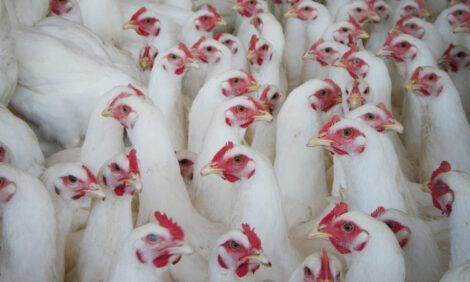



Republic of Korea: Poultry and Products Annual 2009
Growing demand by health-conscious consumers is expected to stimulate a boost to broiler production in South Korea in 2010, according to Sun Young Choi and Michael Francom in the latest GAIN report from USDA Foreign Agricultural Service.Report Highlights
Broiler production in 2010 is forecast to grow for the second straight year, reaching 629,000 tons. Nearly 80 per cent of production is broiler meat. The local chicken industry expects production to grow around five per cent each year for the next decade as local consumers become increasingly aware that chicken, particularly breast meat, is a healthy alternative to red meat. The industry anticipates that the shift towards increased breast meat consumption will require a larger sized broiler averaging 2.0 to 2.5 kg, instead of the current 1.5 kg.
Production
Broiler production in 2010 is forecast to grow for the second straight year, reaching 629,000 tons. Nearly 80 per cent of production is broiler meat. The local chicken industry expects production to grow around five per cent each year for the next decade as local consumers become increasingly aware that chicken, particularly breast meat, is a healthy alternative to red meat. The industry anticipates that the shift towards increased breast meat consumption will require a larger sized broiler averaging 2.0 to 2.5 kg, instead of the current 1.5 kg.
Production in 2009 is estimated at 605,000 tons, rebounding seven per cent from the previous year when avian influenza had wreaked havoc on the local poultry industry. Broiler inventories at the end of June reached record levels as growers responded to a higher farm price, which has nearly doubled since last year to 2,000 won (KRW) per kilo (boneless basis).
This recovery was faster than previously expected as consumer demand remained strong because of earlier efforts to educate consumers about the disease as well as proper handling and cooking instructions. In addition, of the 10 million poultry culled during the 2008 outbreaks of highly pathogenic avian influenza (HPAI), only two to three million were broilers, which were quickly replaced.
Production is also up this year as some restaurants have increased demand for domestic broiler meat in order to minimise the cost and hassle of changing their menus to comply with the new country-of-origin labelling (COOL) requirements. These labelling requirements, which became effective in December 2008, require restaurants serving chicken as well as red meat, rice and kimchi to state the origin of these products on the menu. The Korea Chicken Council (KCC) estimates that there are roughly 80,000 to 90,000 fried chicken restaurants in Korea. The same COOL requirements also apply to the school lunch programme.
The economic recession has also played a minor role in increased production as consumers have started eating more inexpensive chicken. Demand for broiler meat also ticked up slightly during the months following the outbreaks of influenza A H1N1 as consumers briefly switched away from pork to chicken. This was a short-lived trend and is not expected to impact future production at this time.
Consumption
Consumption of domestic broiler meat is expected to rise to 680,000 tons in 2010 and is forecast to grow over the coming years as health-conscious consumers begin to eat more breast meat. In fact, there are advertisements with local celebrities touting the health benefits of chicken.
As noted above, country of origin labelling, the economy and H1N1 influenza have pushed consumption of domestic broiler meat upwards to 663,000 tons in 2009. Consumers are also preparing and eating chicken at home more often than in the past because of the challenging worldwide economic conditions.
Packaging Requirement to Change
The Ministry of Food, Agriculture Forestry & Fisheries (MIFAFF) plans to introduce mandatory packaging requirements to improve the safety of fresh poultry meat beginning in 2010. In particular, under this new standard, fresh poultry meat will be packaged following official inspection and then maintained at a temperature of 2 to 5 degrees Celsius. Imported poultry meat is not subject to this requirement.
The MIFAFF plans to implement this system in 2010 to distinguish domestic chickens and imported chickens to Korean consumers.
Imports
Broiler meat imports in 2010 are expected to climb slightly to 65,000 tons as feed prices settle down and the local currency stabilises. A large percentage of the imported chicken meat will go for processing and other businesses, such as institutions specialising in home delivery. Imports from the United States during this period are estimated at 30,000 tons.
Imports in 2009 are expected to slip from the previous year to 63,000 tons because of the strong international broiler prices and weak local currency during the first six months of 2009. As noted previously, imports are also down in part due to the new COOL requirements for restaurants.
Imports of breast meat, mostly from Brazil, surged to more than 1,000 tons during the first six months of this year, which was 15 times higher than the same period last year, as more young consumers are becoming more diet conscious. With that said, though, the majority of imported chicken meat is still frozen legs or wings, which reached about 24,000 tons in the period January to June of this year.
The United States is the largest supplier of chicken cuts to the Korean market and Brazil is a close second, and China a distant third. US broiler meat shipments are generally bone-in cuts that are bulk packed (15 kg) and are used for processing. Meanwhile, Brazilian meat is typically vacuum packed boneless cuts (2 kg), which is more suited for retail. Chinese broiler meat imports, mostly used by small roadside vendors, are required to be heat-treated since the People's Republic is not recognised as HPAI-free.
Exports
Broiler meat exports continue to grow and are projected to reach 11,000 tons in 2010. Vietnam remains the top export market for Korean poultry meat, most of which is meat from spent hens.
Korea is working closely with USDA's Food Safety and Inspection Service (FSIS) to complete an equivalency review of its heat-treated poultry system. FSIS conducted an audit of the Korean system last autumn and will schedule a follow-up review to ensure the appropriate corrective measures were implemented. The local industry has high hopes that this process will be completed very soon.
Further Reading
| - | You can view the full report by clicking here. |











